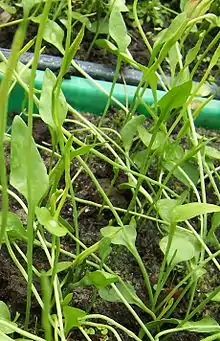Ophioglossum lusitanicum
Ophioglossum lusitanicum, the least adder's-tongue,[1] is a small fern of the family Ophioglossaceae. It is a pan-tropically species categorised as least concern by the IUCN (2001).[2]
| Ophioglossum lusitanicum | |
|---|---|
 | |
| Scientific classification | |
| Kingdom: | Plantae |
| Clade: | Tracheophytes |
| Class: | Polypodiopsida |
| Order: | Ophioglossales |
| Family: | Ophioglossaceae |
| Genus: | Ophioglossum |
| Species: | O. lusitanicum |
| Binomial name | |
| Ophioglossum lusitanicum | |
| Synonyms | |
| |
Description
Ophioglossum lusitanicum is a small winter annual fern, and consists of a simple sterile blade attached to a spike-like fertile blade with between three and eight sunken sporangia on either side. The whole plant rarely exceeds a height of 2 cm.[3]
This species has a chromosome number of 2n = 250–260.[3]
Distribution
Ophioglossum lusitanicum is native to regions bordering the eastern North Atlantic Ocean in Mauritania, Macaronesia (excluding Cape Verde), Morocco, Portugal, France up to the Isles of Scilly and Channel Islands; all countries bordering the Mediterranean; the Caucasus Region and has some records in India and Vietnam.[4]
The distribution in Britain is restricted to one small area of coastal heath on St Agnes, Isles of Scilly where it was discovered by John Raven in 1950. It grows in short turf on Wingletang Down where some of the colonies are suffering from an increase of competitive grasses, gorse (Ulex europaeus) and bramble (Rubus fruticosus).[5] Ophioglossum lusitanicum is listed on Schedule 8 of the Wildlife and Countryside Act 1981, and is within a Site of Special Scientific Interest (SSSI).
In Australasia and South America, this species is represented by a subspecies, Ophioglossum lusitanicum subsp. coriaceum (A. Cunn.) R.T. Clausen [6][7]
Ecology
As this species is a winter annual, it requires a warm winter environment. In its British populations, it favours thin, unshaded, peaty soils in south-facing localities.[8]
Ophioglossum lusitanicum subsp. coriaceum has a much broader ecological range in southern Australia, where habitats include damp open sites; from coast meadows to alpine grassland.[9] It is found in New South Wales, Tasmania, Queensland, and other states.[10]
References
- Clive Stace (1 April 2010). New Flora of the British Isles. Cambridge University Press. pp. 9–. ISBN 978-1-139-48649-1.
- Irudayaraj, V. (2011). "Ophioglossum lusitanicum". IUCN Red List of Threatened Species. 2011: e.T194161A8885861. doi:10.2305/IUCN.UK.2011-1.RLTS.T194161A8885861.en. Retrieved 15 January 2020.
- Stace, Clive, (1997). New Flora of The British Isles, second edition. Cambridge: Cambridge University Press
- "Ophioglossum lusitanicum L." Catalogue of Life. Retrieved 8 December 2020.
- Bennallick, I.J., French, C.F and Parslow, R.E. (2009) Vascular Plants. In CISFBR, Red Data Book for Cornwall and the Isles of Scilly. 2nd Edition. Praze-an-Beeble: Croceago Press.
- The Plant List.org: Ophioglossum lusitanicum subsp. coriaceum
- NZ Plant Conservation Network: Ophioglossum coriaceum
- Online Atlas of the British Flora: Ophioglossum lusitanicum
- Ferns of New South Wales: Ophioglossum lusitanicum
- Royal Botanic Garden Sydney: Ophioglossum lusitanicum
External links
| Wikimedia Commons has media related to Ophioglossum lusitanicum. |
